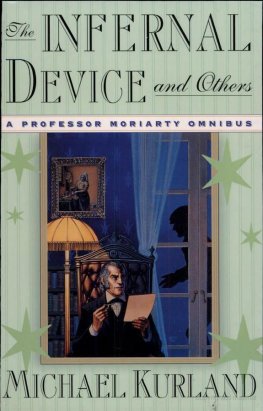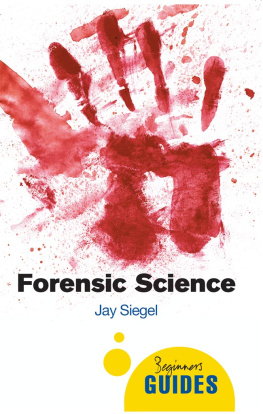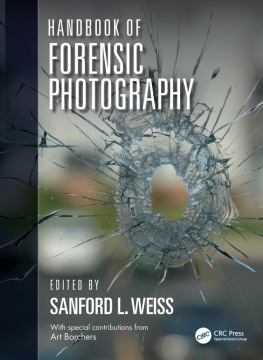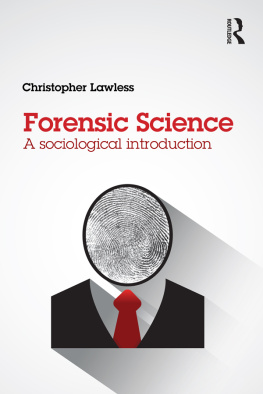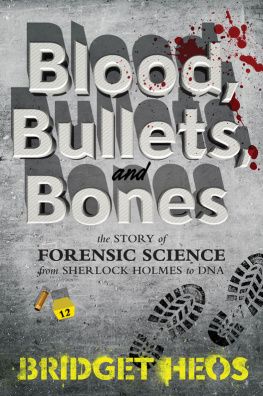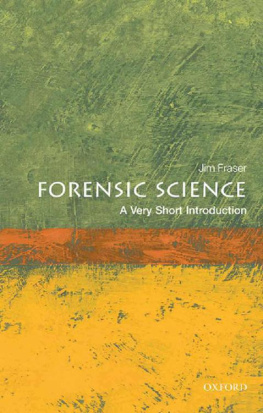Michael Kurland - Irrefutable Evidence: Adventures in the History of Forensic Science
Here you can read online Michael Kurland - Irrefutable Evidence: Adventures in the History of Forensic Science full text of the book (entire story) in english for free. Download pdf and epub, get meaning, cover and reviews about this ebook. year: 2009, publisher: Ivan R. Dee, genre: Detective and thriller. Description of the work, (preface) as well as reviews are available. Best literature library LitArk.com created for fans of good reading and offers a wide selection of genres:
Romance novel
Science fiction
Adventure
Detective
Science
History
Home and family
Prose
Art
Politics
Computer
Non-fiction
Religion
Business
Children
Humor
Choose a favorite category and find really read worthwhile books. Enjoy immersion in the world of imagination, feel the emotions of the characters or learn something new for yourself, make an fascinating discovery.

- Book:Irrefutable Evidence: Adventures in the History of Forensic Science
- Author:
- Publisher:Ivan R. Dee
- Genre:
- Year:2009
- Rating:3 / 5
- Favourites:Add to favourites
- Your mark:
- 60
- 1
- 2
- 3
- 4
- 5
Irrefutable Evidence: Adventures in the History of Forensic Science: summary, description and annotation
We offer to read an annotation, description, summary or preface (depends on what the author of the book "Irrefutable Evidence: Adventures in the History of Forensic Science" wrote himself). If you haven't found the necessary information about the book — write in the comments, we will try to find it.
Irrefutable Evidence: Adventures in the History of Forensic Science — read online for free the complete book (whole text) full work
Below is the text of the book, divided by pages. System saving the place of the last page read, allows you to conveniently read the book "Irrefutable Evidence: Adventures in the History of Forensic Science" online for free, without having to search again every time where you left off. Put a bookmark, and you can go to the page where you finished reading at any time.
Font size:
Interval:
Bookmark:
IRREFUTABLE EVIDENCE
EVIDENCE
Adventures in the History of Forensic Science
Michael Kurland

IRREFUTABLE EVIDENCE. Copyright 2009 by Michael Kurland. All rights reserved, including the right to reproduce this book or portions thereof in any form. For information, address: Ivan R. Dee, Publisher, 1332 North Halsted Street, Chicago 60642, a member of the Rowman & Littlefield Publishing Group. Manufactured in the United States of America and printed on acid-free paper.
www.ivanrdee.com
Library of Congress Cataloging-in-Publication Data:
Kurland, Michael.
Irrefutable evidence / Michael Kurland.
p. cm.
Includes bibliographical references and index.
ISBN 978-1-56663-803-6
1. Evidence, CriminalUnited States. 2. Evidence, ExpertUnited States. 3. Forensic sciences. I. Title.
KF9660.K87 2009
363.25dc22 2009022386
I dedicate this book to
The Bad Companions,
a constant source of inspiration and delight.
You know who you are.
MY THANKS to Linda Robertson for her assistance in research and writing, and for quelling some of my more outrageous ideas. Thanks also to Bicka Barlow, Barry Scheck, William Thompson, and Sandy Zabell, who have shared their knowledge and insights with the forensic community and caused some of it to transfer to me in passing.
M. K.
Petaluma, California
July 2009
But Thomas, one of the twelve, called Didymus, was not with them when Jesus came.
The other disciples therefore said unto him, We have seen the LORD. But he said unto them, Except I shall see in his hands the print of the nails, and put my finger into the print of the nails, and thrust my hand into his side, I will not believe.
And after eight days again his disciples were within, and Thomas with them: then came Jesus, the doors being shut, and stood in the midst, and said, Peace be unto you.
Then saith he to Thomas, Reach hither thy finger, and behold my hands; and reach hither thy hand, and thrust it into my side: and be not faithless, but believing.
John 1:2427
IRREFUTABLE EVIDENCE
There has been murder done, and the murderer was a man. He was more than six feet high, was in the prime of life, had small feet for his height, wore coarse, square-toed boots and smoked a Trichinopoly cigar.
Sherlock Holmes in A Study in Scarlet
OVER THE PAST TWO DECADES forensic science has become a national spectator sport. A substantial majority of the reading and television-viewing public follows the exploits of both real and fictional criminalists as they go about apprehending the wicked. Several successful contemporary fiction seriesamong them those by P. D. James, Patricia Cornwell, Kathy Reichs, and Thomas Harrismake forensic investigation a major part of their plot. Fingerprint analysis, DNA, ballistics, blood spatter, toolmarks, body temperature, and rigor mortis are now topics of everyday conversation. There is scarcely a twelve-year-old child who isnt familiar with the comparison microscope.
The television show CSI (for Crime Scene Investigator) and its spinoffs, in which criminalists use the scientific method to solve crimes, have been among the top prime-time shows for the past decade. In a wave of other showsBones, Cracker, Criminal Minds, Crossing Jordan, Da Vincis Inquest, Dead Men Talking, Extreme Forensics, FBI Files, Forensic Files, NCIS, Post Mortem, Prime Suspect, Profiler, Secrets of Forensic Science, Silent Witness, and Solvedthe forensic investigation of crime is an integral part of the story line. Autopsy close-ups and other gruesome details have replaced the car chases and gratuitous violence of yesteryear.
As one might expect from television programs, with their time limits and need for continuous action, much of the technical detail is wrong, and some of it even wildly incorrect: time intervals are condensed, science is blended skillfully into science fiction, and characters have skills they would never possess in real life. This is not a complainta television shows purpose is to entertain, and no one expects a show about doctors, lawyers, cops, convicts, or, for that matter, spirit mediums to be in 100 percent correlation with the real world.
When did this popular interest begin? In the early years of the nineteenth century, the rise of literacy occasioned a demand for cheap, sensational literature. And this demand was filled in part by true crime stories. Lurid newspaper accounts were often released as pamphlets featuring overly graphic covers.
James Gordon Bennett, publisher of the New York Herald, became the first investigative reporter when he personally examined the scene of the murder in 1836 of twenty-three-year-old Helen Jewett, one of the girls of the Palace of Passions on Thomas Street in Manhattan. Here he describes the girls body in classical terms:
Slowly I began to discover the lineaments of the corpse, as one would the beauties of a statue of marble. It was the most remarkable sight I ever beheldI never have, and never expect to see such another. My God, exclaimed I, how like a statue! I can scarcely conceive that form to be a corpse. Not a vein was to be seen. The body looked as whiteas fullas polished as the purest Parisian marble. The perfect figurethe exquisite limbsthe fine facethe full armsthe beautiful bustallall surpassed in every respect the Venus de Medicis, according to the casts generally given of her.... For a few moments I was lost in admiration at this extraordinary sighta beautiful female corpsethat surpassed the finest statue of antiquity.
This overwrought description is certainly inaccurate. In fact, after she was battered and hacked to death with an ax, the poor girls body was set on fire.
The case of the Beautiful Cigar Girl, Mary Rogers, served as a platform for Bennetts attack on city government. Three days after disappearing from her Manhattan home, Rogers was found floating in the Hudson River off Hoboken, New Jersey.
The recent awful violation and murder of an innocent young womanthe impenetrable mystery which surrounds that actthe apathy of the criminal judges, sitting on their own fat for a cushion benchand the utter inefficiency of the police, are all tending fast to reduce this large city to a savage state of societywithout lawwithout orderand without security of any kind.
The case was never solved. The known facts provided the background for several fictionalized accounts, among them J. H. Ingrahams dime novel The Beautiful Cigar Girl or the Mysteries of Broadway and Edgar Allan Poes The Mystery of Marie Rogt. Poe turned New York into Paris and the Hudson into the Seine. Under that guise, as he explained in a letter to a friend, he provided a rigorous analysis of the actual case and suggested several possible solutions.
In the late nineteenth century, Conan Doyles Sherlock Holmes and R. Austin Freemans Dr. Thorndyke blazed the fictional path toward rational crime-solving. Holmes used deduction (actually induction) with a dash of science, and Thorndyke added a heavy dose of scientific analysis. It was around this time that the first scientific crime solvers appeared in the real-life police forces of several European countries. Alphonse Bertillon, Edward Richard Henry, Hans Gross, Bernard Spilsbury, and a host of others applied scientific methods to police work. And mirabile dictu, they solved crimes.
Forensic detectives soon became a standard fixture in mystery literature. Jacques Futrelles Professor S. F. X. Van Dusen, M.D., Ph.D., LL.D., F.R.S.; Arthur B. Reeves chemistry professor Craig Kennedy; and others attempted to use scientific methods (to the extent that their authors understood them) to solve crimes. Even Dame Agatha Christie, though primarily a writer of cozies, kept up on the latest information about rare poisons. The appeal of this new genre is spoken of by Hugo Gernsback in
Next pageFont size:
Interval:
Bookmark:
Similar books «Irrefutable Evidence: Adventures in the History of Forensic Science»
Look at similar books to Irrefutable Evidence: Adventures in the History of Forensic Science. We have selected literature similar in name and meaning in the hope of providing readers with more options to find new, interesting, not yet read works.
Discussion, reviews of the book Irrefutable Evidence: Adventures in the History of Forensic Science and just readers' own opinions. Leave your comments, write what you think about the work, its meaning or the main characters. Specify what exactly you liked and what you didn't like, and why you think so.

